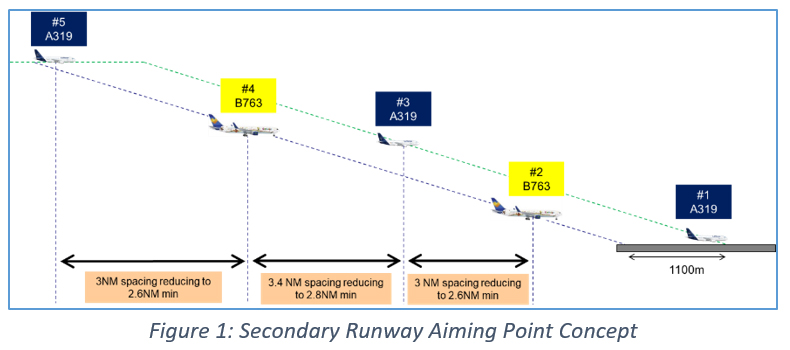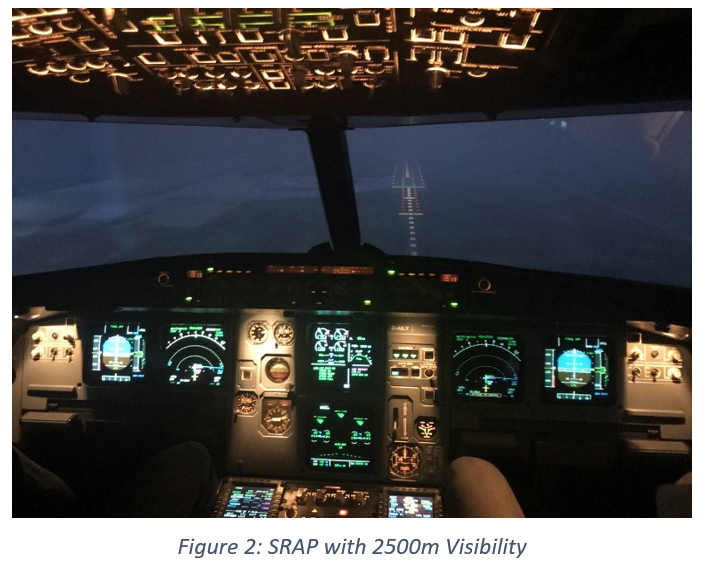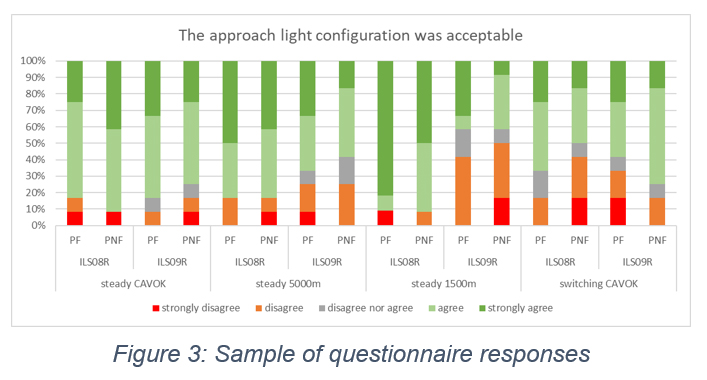SESAR research partners recently evaluated “secondary runway aiming point (SRAP)” and “Increased Glide Slope (IGS)”, two concepts aimed at optimising runway capacity and minimising noise. The testing was carried out by SESAR JU founding member, Eurocontrol, in partnership with Lufthansa Aviation Training (LAT).
SRAP permits ‘light wake’ category aircraft to fly a final approach above the approach profile of heavier aircraft flying to the primary runway threshold; this enables them to avoid the wake vortex of the larger aircraft, and should result in an increase in runway throughput of up to 5% (based on the best combination of flights of the traffic sample analysed) (see Figure 1).
Crucially, the noise contour of the aircraft on approach to the SRAP moves towards the airport, reducing noise. The approach glide slope to the SRAP could be a normal “3-degree” slope or an increased glide slope (IGS) to maximise benefits.
The background
The two concepts under investigation are part of SESAR candidate solution “Enhanced arrival procedures”, which focuses on mitigating noise and adapting wake avoidance procedures. Both concepts have already been successfully trialled in a number of real-time simulations.
The solution has been developed within SESAR 2020 project PJ02 “Increased runway and airport throughput”, which seeks to tackle capacity challenges at major airports.
The evaluated concepts
To evaluate the feasibility from a pilot point of view, co-founding SESAR JU member flight simulations were run in a professional Level D (highest degree of realism) full-motion Airbus A319 flight crew training simulator operated by Lufthansa Aviation Training.

The visual system designed and implemented in the simulator to replicate runway markings, runway lights, approach lights and PAPI for both the primary and the Secondary Runway Aiming Points were, as far as possible, compliant with ICAO Annex 14 provisions.
The SRAP itself was located 1,100 m after the primary runway threshold.
A standard ILS with a 3-degree glide slope was implemented serving the primary runway aiming point. For the SRAP, a GLS (ILS-like) approach with a 3-degree glide slope and an RNP approach with a 3.5 degree glide path to simulate an Increased Glide Slope (IGS) operation were flown. The simulated airport was Munich.
Two variants of the concept were tested with pilots:
Approaches with all lights illuminated, i.e. threshold lights and approach lights of both primary and secondary aiming points remained switched on
Approaches with threshold and approach lights illuminated for only one aiming point, serving the first aircraft in the approach sequence. Once this aircraft had landed, the threshold and approach lights for the aiming point of the next aircraft in the approach sequence were switched on.

A total of 12 simulator sessions were conducted with A319 type-rated pilots (12 crews consisting of 2 pilots each).
During each session, 14 approaches were flown to test variously ILS approaches to the primary or secondary aiming point, and RNP approaches with Increased Glide Slope to the secondary aiming point under both steady and switched runway and approach light configurations.
Furthermore, the test approaches ran under a variety of visual conditions ranging from CAVOK to 2,500 m visibility. Figure 2 illustrates the visual conditions during an RNP 3.5º approach to the SRAP with steady lights and 2,500 m visibility.
Concept feasibility was evaluated with 24 pilots flying 14 approaches which were measured using video recordings indicating the visual conditions experienced by the pilots and data recordings of flight parameters like aircraft 3D position, vertical speed, airspeed, thrust, weight, etc. to assess approach and landing performance.
Pilots were also asked to complete a questionnaire after each approach containing questions about visual indications, workload and safety, as well as one questionnaire at the end of each simulator session with general questions on the acceptability of the concept.

Initial results regarding the acceptability of the approach lights in different scenarios are promising, suggesting the lighting configurations tested were acceptable in most visibility conditions for the majority of pilots.
A full report on the aircraft flight simulations is expected by the end of October 2019, and will provide valuable input into the final development activities starting in January 2020.
The value of involving flight crew and using high-fidelity full-motion aircraft simulators is critical to completing the initial safety and operational validation of promising new concepts.
With capacity and the environment representing significant challenges for aviation, ensuring pilots can safely fly, and that aircraft are able to navigate these new procedures, is a necessity. Together SESAR JU members and partners will undertake additional trials to bring a validated SRAP concept to the level of maturity by 2023. This will include assessing impact of these new solutions on the airspace and procedures.
